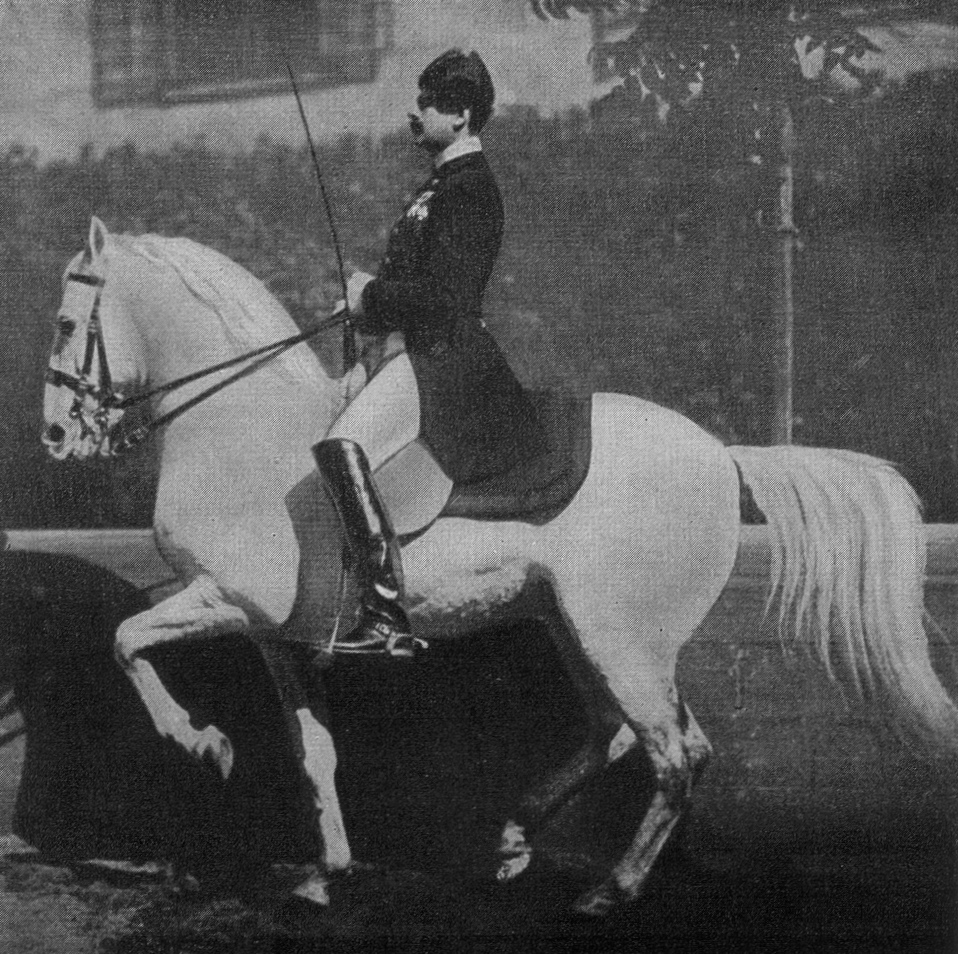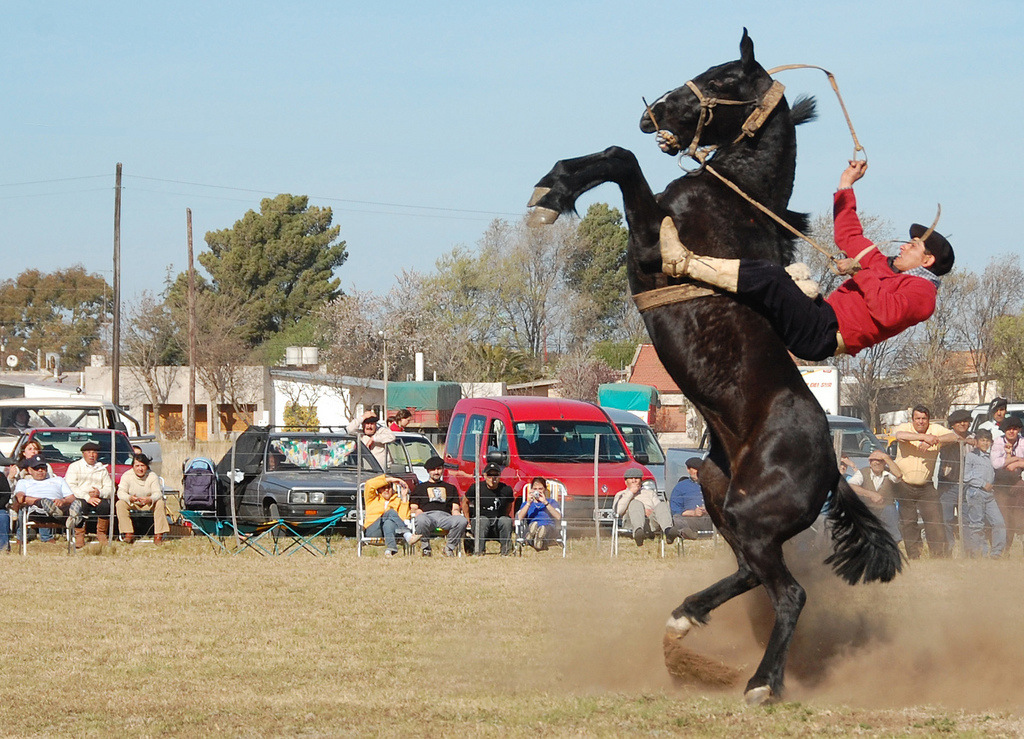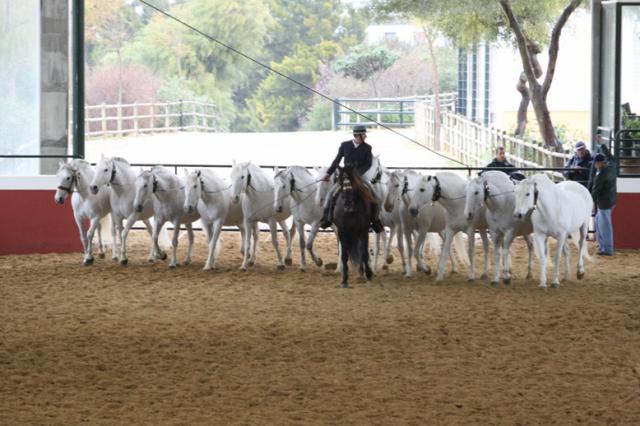|
Airs Above The Ground
The airs above the ground or school jumps are a series of higher-level, Haute ecole, classical dressage movements in which the horse leaves the ground. They include the capriole, the courbette, the mezair, the croupade and the levade. None are typically seen in modern competitive dressage. They are performed by horses of various riding academies such as the Spanish Riding School in Vienna and the Cadre Noir in Saumur, and may be seen in other dressage performances. The levade and courbette are a particular feature of the Doma Menorquina, the riding tradition of the island of Menorca. Horses such as the Andalusian, Lusitano, Lipizzan and Menorquín are the breeds most often trained to perform the airs today, in part due to their powerfully conformed hindquarters, which allow them the strength to perform these difficult movements. There were originally seven airs, many of which were used to build into the movements performed today. There is a popular conception that these ... [...More Info...] [...Related Items...] OR: [Wikipedia] [Google] [Baidu] |
Menorca
Menorca or Minorca (from la, Insula Minor, , smaller island, later ''Minorica'') is one of the Balearic Islands located in the Mediterranean Sea belonging to Spain. Its name derives from its size, contrasting it with nearby Majorca. Its capital is Mahón ( ca, Maó), situated on the island's eastern end, although Menorca is not a province and forms a political union with the other islands in the archipelago. Ciutadella and Mahon are the main ports and largest towns. The port of Mahon is the second biggest natural port in the world. Menorca has a population of approximately 93,397 (at 1 January 2019). It is located 39°47' to 40°00'N, 3°52' to 4°24'E. Its highest point, called El Toro (from Catalan "''turó''" meaning ''hill''), is above sea level. History The island is known for its collection of megalithic stone monuments: ''navetes'', ''taules'' and ''talaiots'', which indicate very early prehistoric human activity. Some of the earliest culture on Menorca w ... [...More Info...] [...Related Items...] OR: [Wikipedia] [Google] [Baidu] |
Dressage Terminology
Dressage ( or ; a French term, most commonly translated to mean "training") is a form of horse riding performed in exhibition and competition, as well as an art sometimes pursued solely for the sake of mastery. As an equestrian sport defined by the International Equestrian Federation, dressage is described as "the highest expression of horse training" where "horse and rider are expected to perform from memory a series of predetermined movements." Competitions are held at all levels from amateur to the Olympic Games and World Equestrian Games. Its fundamental purpose is to develop, through standardized progressive training methods, a horse's natural athletic ability and willingness to perform, thereby maximizing its potential as a riding horse. At the peak of a dressage horse's gymnastic development, the horse responds smoothly to a skilled rider's minimal aids. The rider is relaxed and appears effort-free while the horse willingly performs the requested movement. The discipl ... [...More Info...] [...Related Items...] OR: [Wikipedia] [Google] [Baidu] |
Mezair or school jumps performed by horses in classical dressage.
{{disambig ...
Mezair may refer to: * Hichem Mezaïr, an Algerian footballer * One of the Airs above the ground The airs above the ground or school jumps are a series of higher-level, Haute ecole, classical dressage movements in which the horse leaves the ground. They include the capriole, the courbette, the mezair, the croupade and the levade. None ar ... [...More Info...] [...Related Items...] OR: [Wikipedia] [Google] [Baidu] |
Collection (horse)
{{Unreferenced, date=June 2009 Collection occurs when a horse's center of gravity is shifted backwards. Energy is directed in a more horizontal trajectory with less forward movement (limbs generate higher vertical impulses). Biomechanical markers include: increased flexion in the lumbo-sacral joint, stifle, and hocks of the horse; increased engagement of the thoracic sling muscles resulting in the withers rising relative to the horse's scapula; and reduced ranges of limb protraction–retraction. Collection in riding Collection is also an important ingredient in riding, if the rider wishes to perform more advanced movements or jumping. It not only allows the horse to move more easily and athletically, but also helps prevent wear-and-tear on the front legs. Through training, the horse learns to collect itself when requested to do so by the rider. The observer receives the impression of great strength held under perfect control. The most readily apparent form of collection can ... [...More Info...] [...Related Items...] OR: [Wikipedia] [Google] [Baidu] |
Piaffe
The piaffe () is a dressage movement where the horse is in a highly collected and cadenced trot, in place or nearly in place. The center of gravity of the horse should be more towards the hind end, with the hindquarters slightly lowered and great bending of the joints in the hind legs. The front end of the horse is highly mobile, free, and light, with great flexion in the joints of the front legs, and the horse remains light in the hand. The horse should retain a clear and even rhythm, show great impulsion, and ideally should have a moment of suspension between the foot falls. As in all dressage, the horse should perform in a calm manner and remain on the bit with a round back.Carlos Henriques Pereira, « Le piaffer », dans Dressage et Ethologie, Editions Amphora, 2011, 285 pp. 202-211. The piaffe was originally used in battle to keep the horse focused, warm, and moving, ready to move forward into battle. In modern times, the piaffe is mostly taught as an upper level movement in ... [...More Info...] [...Related Items...] OR: [Wikipedia] [Google] [Baidu] |
Rear (horse)
Rearing occurs when a horse or other equine "stands up" on its hind legs with the forelegs off the ground. Rearing may be linked to fright, aggression, excitement, disobedience, non experienced rider, or pain. It is not uncommon to see stallions rearing in the wild when they fight, while striking at their opponent with their front legs. Mares are generally more likely to kick when acting in aggression, but may rear if they need to strike at a threat in front of them. When a horse rears around people, in most cases, it is considered a dangerous habit for riding horses, as not only can a rider fall off from a substantial height, but also because it is possible for the animal to fall over backwards, which could cause injuries or death to both horse and rider. It is therefore strongly discouraged. A horse that has a habit of rearing generally requires extensive retraining by an experienced horse trainer, and if the habit cannot be corrected, they horse may be deemed too dangerou ... [...More Info...] [...Related Items...] OR: [Wikipedia] [Google] [Baidu] |
Menorquín Horse
The Menorquín or ca, Cavall Menorquí, italic=no is a breed of horse indigenous to the island of Menorca in the Balearic Islands, from which it takes its name. It is closely associated with the doma menorquina style of riding. History Menorca was under Moorish domination from 903 to 1287. According some sources, research has shown links between the Menorquín and Arab breeds, while others have shown it to be of Berber origin, and yet others believe that it was brought to Menorca from central Europe by King James I of Aragon James I the Conqueror ( es, Jaime el Conquistador, ca, Jaume el Conqueridor; 2 February 1208 – 27 July 1276) was King of Aragon and Lord of Montpellier from 1213 to 1276; King of Majorca from 1231 to 1276; and Valencia from 1238 to 12 .... According to the Government of the Balearic Islands, it belongs to the eastern group of indigenous Iberian horses which also included the now extinct Catalan horse. The Menorquín was officially re ... [...More Info...] [...Related Items...] OR: [Wikipedia] [Google] [Baidu] |
Lipizzan
The Lipizzan or Lipizzaner ( hr, Lipicanac, cz, Lipicán, hu, Lipicai, it, Lipizzano, sr, Lipicaner, sl, Lipicanec), is a European horse breed, breed of riding horse developed in the Habsburg Empire in the sixteenth century. It is of Baroque horse, Baroque type, and is powerful, slow to mature and long-lived; the coat is usually gray (horse), gray. The name of the breed derives from that of the village of Lipica, Sežana, Lipica ( it, Lipizza), now in Slovenia, one of the earliest stud farms established, then part of Austria-Hungary; the stud farm there is still active. The breed has been endangered numerous times by warfare sweeping Europe, including during the War of the First Coalition, World War I, and World War II. The rescue of the Lipizzans during World War II by American troops was made famous by the Disney movie ''Miracle of the White Stallions''. The Lipizzaner is closely associated with the Spanish Riding School of Vienna, Austria, where the horses demonstrate ... [...More Info...] [...Related Items...] OR: [Wikipedia] [Google] [Baidu] |
Lusitano
The Lusitano, also known as the Pure Blood Lusitano or PSL (''Puro Sangue Lusitano''), is a Portuguese horse breed. Horses were known to be present on the Iberian Peninsula as far back as 20,000 BC, and by 800 BC the region was renowned for its war horses. The fame of the horses from Lusitania goes back to the Roman Age, which attributed its speed to the influence of the West wind, who was considered capable of fertilizing the mares. When the Muslims invaded Iberia in 711 AD, they brought Arabian horses with them that were crossed with the native horses, developing a horse that became useful for war, dressage and bull fighting. The Portuguese horse was named the Lusitano, after the word Lusitania, the ancient Roman name for the region that modern Portugal occupies. There are four main breed lineages within the breed today, and characteristics differ slightly between each line. Lusitanos can be any solid color, although they are generally gray, bay or chestnut. Horses of th ... [...More Info...] [...Related Items...] OR: [Wikipedia] [Google] [Baidu] |
Andalusian Horse
The Andalusian, also known as the Pure Spanish Horse or PRE (Spanish language literally translates to “Spanish pure breed”. This name is sometimes capitalized when used in English-language publications, but is all lower-case in Spanish, which does not capitalize adjectives derived from proper nouns.), is a horse breed from the Iberian Peninsula, where its ancestors have lived for thousands of years. The Andalusian has been recognized as a distinct breed since the 15th century, and its conformation has changed very little over the centuries. Throughout its history, it has been known for its prowess as a war horse, and was prized by the nobility. The breed was used as a tool of diplomacy by the Spanish government, and kings across Europe rode and owned Spanish horses. During the 19th century, warfare, disease and crossbreeding reduced herd numbers dramatically, and despite some recovery in the late 19th century, the trend continued into the early 20th century. Exports ... [...More Info...] [...Related Items...] OR: [Wikipedia] [Google] [Baidu] |
Doma Menorquina
Doma menorquina is the traditional style of riding of the island of Menorca. It is closely associated with the Menorquín horse. Doma menorquina is based on classical dressage and resembles a combination of Haute Ecole (dressage) ("High School") and Doma vaquera disciplines. Usually, stallions 3–4 years old are trained. From the three basic gaits, walk, trot and gallop, training progresses to the Spanish walk, half pass, flying changes and piaffe and culminates in the ''bot'', or walking courbette. The remarkable ability of Menorcan horses in the ''bot'' is the most notable element of Menorcan riding; the rider sits effortlessly on the rigid back of the , the Menorcan saddle. Horses and riders are at the centre of local celebrations, in a tradition that may go back to the 14th century and incorporate elements of Christian, pagan and Moorish ritual. Some 150 riders participate in the festival of ''Mare de Déu de Gràcia'', the Birth of Mary, in Mahón (September 8–9) an ... [...More Info...] [...Related Items...] OR: [Wikipedia] [Google] [Baidu] |






_Spanish_battle_stallion_1603.jpg)

